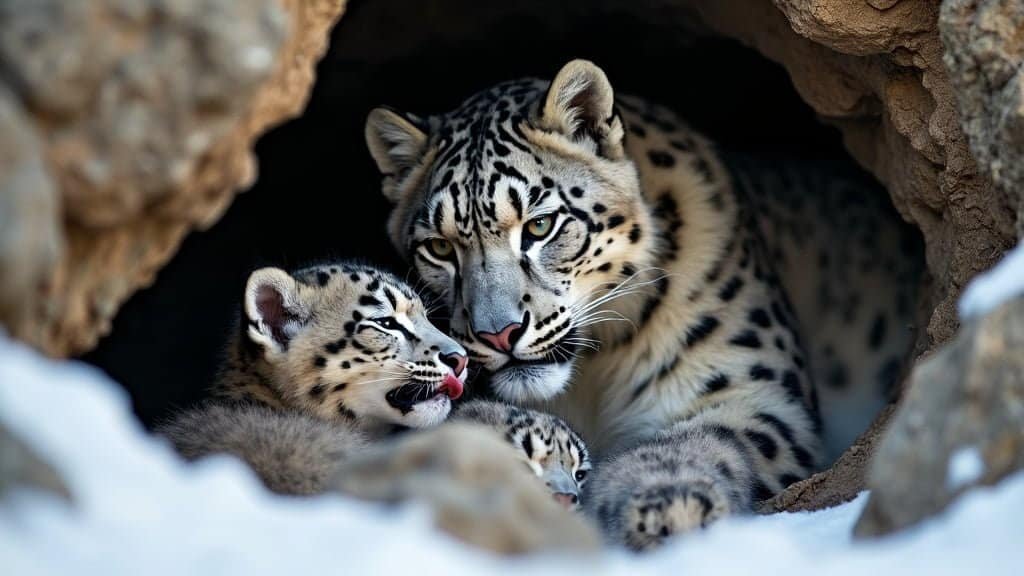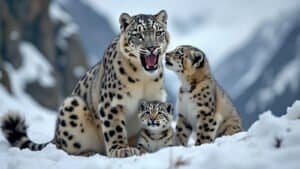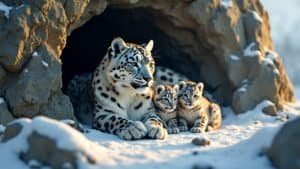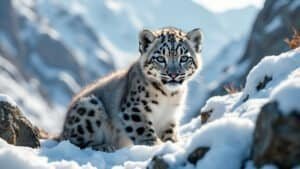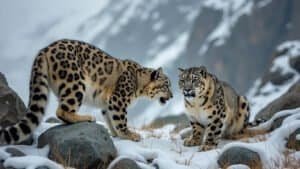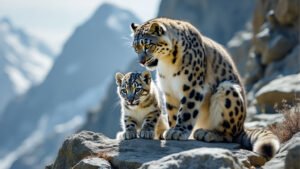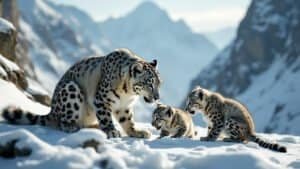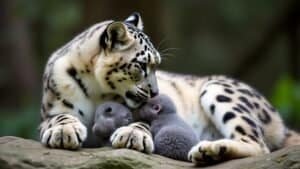Introduction
In the harsh and rugged terrains where snow leopards thrive, the care of their newborn cubs is both a delicate and vital process. During the first few weeks, snow leopard mothers focus intently on nurturing and protecting their young, ensuring their survival in these extreme environments
This article explores the meticulous ways in which these elusive cats prepare their dens, feed their cubs, and safeguard them from potential dangers. By understanding these behaviors, we gain insight into the critical early stages of life for snow leopard cubs
How Snow Leopard Mothers Prepare Their Den
Snow leopard mothers begin their journey of motherhood with a critical task: preparing a secure and suitable den for their cubs. This process is essential to ensure the survival of the vulnerable newborns in the challenging environment where these elusive cats reside
The choice of location, the structure of the den, and the measures taken to keep the cubs safe from predators and the elements are all integral parts of this process
Choosing the Right Location
The selection of a den site is a vital decision for a snow leopard mother. Typically, she will choose a location that is remote, difficult to access, and well-hidden from predators
Mountainous regions with steep cliffs, rocky outcrops, and dense vegetation are preferred as they offer natural protection. These areas are less likely to be frequented by large predators or human disturbances, providing a safer environment for the cubs
Studies have shown that snow leopards often use existing caves or crevices as dens, taking advantage of the natural insulation and concealment they provide
Nest Building and Arrangement
Once a suitable location is identified, the snow leopard mother will focus on making the den comfortable and secure for her cubs. She may line the floor with soft materials, such as her own fur, grass, or other vegetation, creating a warm and cushioned environment
This not only provides comfort but also helps insulate the cubs against the cold temperatures typical of high-altitude habitats. The mother will also arrange the den in a way that maximizes warmth and minimizes exposure to the wind and weather, ensuring that the cubs remain safe and comfortable during the early weeks of their lives
Ensuring Safety from Predators
The safety of the cubs is the snow leopard mother’s top priority. To protect them from predators, such as wolves and eagles, as well as from potential threats like avalanches or rockslides, the mother carefully chooses dens that are well-concealed and difficult to access
The den’s location is often in rugged, hard-to-reach areas where larger predators cannot easily navigate. Moreover, snow leopards are known for their exceptional camouflage, which helps the mother blend into her surroundings and keep the den hidden from prying eyes. Additionally, the mother is highly vigilant and will often move her cubs to a new den if she perceives any threats to their safety
By meticulously preparing the den and taking these precautions, the snow leopard mother ensures that her cubs have the best possible start in life, protected from the harsh elements and potential dangers of their mountainous environment
Behavior of Snow Leopard Cubs After Birth
The first few weeks of life are a critical period for snow leopard cubs, characterized by rapid development and intense bonding with their mother
Born in a state of extreme vulnerability, these cubs rely entirely on their mother for nourishment, protection, and warmth. During this time, the cubs’ behavior is primarily focused on survival and growth, with gradual milestones marking their early development
Early Stages: Blind and Helpless
When snow leopard cubs are born, they are blind, deaf, and completely helpless. Typically, a litter consists of one to three cubs, though larger litters are not uncommon
At birth, each cub weighs just around 11 to 22 ounces, making them extremely fragile and dependent on their mother. For the first week or two, the cubs’ eyes remain closed, and they rely solely on touch and smell to navigate their surroundings and locate their mother
Their primary activities during this stage are feeding and sleeping, both of which are crucial for their rapid growth and development
Mother-Infant Bonding
The bond between a snow leopard mother and her cubs is exceptionally strong during these early weeks. The mother spends almost all of her time in the den, attending to her cubs and ensuring they are well-fed and warm
This close physical contact not only provides the cubs with necessary warmth but also helps strengthen the emotional bond between mother and offspring. The mother’s constant presence reassures the cubs, helping them feel secure in their environment
She will gently groom them, a behavior that not only keeps the cubs clean but also promotes bonding and stimulates their circulation and digestion
Gradual Development of Senses
As the weeks progress, snow leopard cubs begin to open their eyes, usually around 7 to 10 days after birth. Their blue eyes, which will gradually change color as they age, are initially cloudy but begin to clear as they grow stronger
With the opening of their eyes, the cubs start to explore their immediate surroundings, albeit in a limited capacity. Their hearing also develops around the same time, allowing them to respond to their mother’s calls and other sounds in the environment. By the time they are about two weeks old, the cubs become more active within the den, starting to crawl and interact with each other
Despite these advancements, the cubs remain highly dependent on their mother, who continues to provide all their nutritional and safety needs. The early development of these senses is crucial as it marks the beginning of the cubs’ journey toward independence, though they will still rely heavily on their mother for several more months
Feeding and Nutrition of Snow Leopard Cubs
Feeding is a crucial aspect of a snow leopard mother’s care for her cubs, especially in the early weeks of their lives. The nutritional support provided by the mother ensures that the cubs grow rapidly, building the strength and immunity needed to survive in their harsh environment
This section delves into the specifics of how snow leopard mothers nourish their young and the important stages of their early feeding process
Mother’s Milk and Nutritional Needs
For the first few weeks, snow leopard cubs depend entirely on their mother’s milk, which is rich in the essential nutrients required for their growth
The milk provides a perfect balance of fat, protein, and antibodies that help the cubs develop their immune systems, protect against infections, and promote healthy weight gain
Given the remote and challenging habitats where snow leopards live, the mother’s milk is the cubs’ sole source of nutrition, ensuring they get the vital nutrients needed to thrive in an environment where food is not always plentiful
The mother herself must maintain her health and strength to produce sufficient milk. During this period, she needs to feed well, relying on her hunting skills to catch prey that will sustain both her and her nursing cubs. Depending on the availability of prey, the mother may need to leave the den briefly to hunt, returning quickly to ensure her cubs are not left unattended for too long
Frequency and Duration of Feeding
In the initial weeks, the cubs feed frequently, often nursing every few hours. Each feeding session can last anywhere from a few minutes to over half an hour, depending on the cubs’ needs and the mother’s milk supply
During this time, the cubs are entirely focused on feeding, which is essential for their rapid growth. The mother is highly attentive during these sessions, often licking and grooming the cubs afterward to clean them and stimulate digestion
As the cubs grow, the frequency of feeding gradually decreases, although the amount of milk consumed during each session increases. This adjustment ensures that the cubs continue to receive the necessary nutrition while also allowing the mother some time to rest and recover
Weaning Process and Timeline
Weaning, the gradual process of transitioning from mother’s milk to solid food, typically begins when the cubs are about two months old. However, the exact timing can vary depending on the cubs’ development and the availability of food
The mother will start bringing back small portions of meat from her hunts, initially as a supplement to the milk. This introduction to solid food is crucial for the cubs as it prepares their digestive systems for the more substantial diet they will need as they grow
During the weaning period, the cubs continue to nurse, but with decreasing frequency as they become more accustomed to eating solid food. By the time the cubs are around three to four months old, they may begin accompanying their mother on short hunting trips, learning crucial survival skills that will prepare them for eventual independence
Full weaning is usually completed by the time the cubs are six months old, although they may still nurse occasionally if the mother allows it
This process of feeding and weaning is vital for the cubs’ survival, ensuring they develop the strength, skills, and independence necessary to thrive in the wild. The mother’s role during this period is not only to nourish her cubs but also to prepare them for the challenges they will face as they grow
Protection and Safety of Snow Leopard Cubs
Ensuring the safety of her cubs is one of the primary responsibilities of a snow leopard mother. The harsh environment and potential threats from predators make protection a crucial aspect of early cub care
This section explores how snow leopard mothers vigilantly guard their cubs and employ various strategies to keep them safe during their most vulnerable weeks
Maternal Vigilance and Defense
Snow leopard mothers are highly protective and vigilant, constantly monitoring their surroundings for any signs of danger. Their natural instinct is to remain close to the den, ensuring that their cubs are never left unattended for long periods
The mother uses her keen senses to detect potential threats, such as other predators like wolves, which may pose a danger to the cubs. If a threat is perceived, the mother will often move the cubs to a new, safer location, a strategy known as den-shifting. This proactive behavior helps minimize the risk of discovery by predators and reduces the chances of a surprise attack
In addition to relocation, the mother is ready to defend her cubs fiercely if necessary. Although snow leopards are generally solitary and elusive animals, a mother will not hesitate to confront a threat head-on if her cubs are in danger. Her powerful build, sharp claws, and strong bite make her a formidable opponent, even against larger predators
Camouflage and Concealment Techniques
The natural environment where snow leopards live provides excellent opportunities for camouflage, which the mother expertly uses to her advantage
The rocky, snow-covered terrain of their habitat blends seamlessly with the snow leopard’s thick, spotted fur, allowing them to remain hidden from predators and prey alike. This natural camouflage is especially important for cubs, who are born with a similarly patterned coat that helps them remain unseen when they stay close to their mother or within the den
The mother also ensures that the den is well-concealed. Choosing locations that are difficult to access and hidden among rocks or dense vegetation, she reduces the likelihood of predators stumbling upon the den
The entrance to the den is often small and narrow, further enhancing its concealment and making it difficult for larger predators to enter
Responding to External Threats
When faced with an external threat, a snow leopard mother employs a range of strategies to protect her cubs
In some cases, she may use distraction techniques, such as leading a predator away from the den by making herself visible and then quickly retreating to a different area. This tactic can successfully divert attention away from the cubs, giving them a better chance of remaining undiscovered
Another common response is to remain completely still and silent, relying on her camouflage and the hidden location of the den to avoid detection. This passive defense strategy is often effective, as many predators rely on movement to spot potential prey. By staying motionless, the mother can keep both herself and her cubs safe from harm
In extreme cases, the mother may choose to abandon the den temporarily if she believes it has been compromised. She will relocate the cubs to a new, safer den as soon as the threat has passed, continuing to protect them through careful vigilance and strategic planning
Through these protective measures, snow leopard mothers ensure the survival of their cubs in an environment where dangers are ever-present. Their ability to combine physical defense with clever strategies makes them highly effective at safeguarding their young during the critical early weeks of life
Conclusion
The first few weeks of a snow leopard cub’s life are a critical period that requires careful and dedicated care from the mother. From the meticulous preparation of a secure den to the nurturing feeding process and vigilant protection against potential threats, snow leopard mothers play an essential role in ensuring their cubs’ survival
The cubs, born blind and helpless, gradually develop their senses and strength under the close watch of their mother, who provides them with the nourishment and safety they need to thrive in the harsh mountainous environment
By understanding these behaviors, we gain a deeper appreciation of the challenges snow leopards face in the wild and the extraordinary lengths to which mothers go to protect and nurture their young
